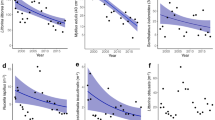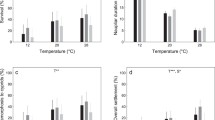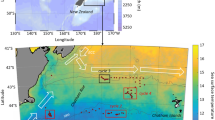Abstract
Large populations of sea urchins, Strongylocentrotus droebachiensis (Müller), destroyed kelp beds along the Atlantic coast of Nova Scotia in the 1960's and 1970's. The origin of these large sea urchin populations is not understood. We have investigated the potential influence of variable growth and development of the planktonic larvae of sea urchins (in response to temperature and food abundance) on recruitment of benthic juveniles. The adult sea urchins were collected at Sandy Cove, Digby County, Nova Scotia, Canada, in December 1986. Temperature strongly affected larval size and the growth of the echinus rudiment within the range 3° to 9°C, and larvae grew most rapidly at 14°C. Food abundance had a smaller effect on larval growth, and these effects were apparent only at high temperature. Larvae fed the same concentration of two different algal food species grew and developed similarly. Correspondence between spring temperature variation and qualitative variation in sea urchin recruitment, as well as strong temperature effects on larval growth in culture, and the occurrence of a large, positive temperature anomaly in June 1960, all suggest that temperature effects on larval growth and development may have led to intense sea urchin recruitment in 1960 and the appearance of large adult populations 4 to 6 yr later. This result invites further research.
Similar content being viewed by others
Literature cited
Birkeland, C. (1982). Terrestrial runoff as a cause of outbreaks of Acanthaster planci (Echinodermata: Asteroidea). Mar. Biol. 69: 175–185
Breen, P. A., Mann, K. H. (1976a). Changing lobster abundance and the destruction of kelp beds by sea urchins. Mar. Biol. 34: 137–142
Breen, P. A., Mann, K. H. (1976b). Destructive grazing of kelp by sea urchins in Eastern Canada. J. Fish. Res. Bd. Can. 33: 1278–1283
Camp, D. K., Cobb, S. P., Van Breedveld, J. F. (1973). Overgrazing of seagrasses by a regular urchin, Lytechinus variegatus. Biosci. 23: 37–38
Chapman, A. R. O. (1986). Population and community ecology of seaweeds. Adv. Mar. Biol. 23: 1–161
Ebert, T. (1983). Recruitment in echinoderms. In: Jangoux, M., Lawrence, J. M. (eds.) Echinoderm Studies. Vol. 1. A. A. Balkema, Rotterdam, p. 169–203
Elner, R. W. (1980). Predation on the sea urchin (Strongylocentrotus droebachiensis) by the American lobster (Homarus americanus) and the rock crab (Cancer irroratus). In: Pringle, J. D., Sharp, G. J., Caddy, J. F. (eds.) Proceedings of the workshop on the relationships between sea urchin grazing and commercial plant/animal havesting. Can. tech. Rept. Fish. Aquat. Sci., Halifax p. 954
Emlet, R. B. (1986). Facultative planktotrophy in the tropical echinoid Clypeaster rosaceus (Linnaeus) and a comparison with obligate planktotrophy in Clypeaster subdepressus (Gray) (Clypeasteroidea: Echinoidea). J. exp. mar. Biol. Ecol. 95: 183–202
Evans, P. D., Mann, K. H. (1977). Selection of prey by American lobsters (Homarus americanus) when offered a choice between sea urchins and crabs. Can. J. Fish. aquat. Sci. 34: 2203–2207
Fenaux, L., Cellario, C., Etienne, M. (1985). Croissance de la larve de l'oursin Paracentrotus lividus. Mar. Biol. 86: 151–157
Foreman, R. E. (1977). Benthic community modification and recovery following intensive grazing by Strongylocentrotus droebachiensis. Helgoländer wiss. Meeresunters. 30: 468–484
Hagen, N. T. (1983). Destructive grazing of kelp beds by sea urchins in Vestfjorden, northern Norway. Sarsia 68: 177–190
Highsmith, R. C., Emlet, R. B. (1986). Delayed metamorphosis: effect on growth and survival of juvenile sand dollars (Echinoidea: Clypeasteroida). Bull. mar. Sci. 39: 347–361
Himmelman, J. H. (1978). Reproductive cycle of the green sea urchin, Strongylocentrotus droebachiensis. Can J. Zool. 56: 1828–1836
Hinegardner R. T. (1969). Growth and development of the laboratory cultured sea urchin. Biol. Bull. mar. biol. Lab., Woods Hole 137: 465–475
Hollister, H. J., Sandnes, A. M. (1972). Sea surface temperatures and salinities at shore stations on the British Columbia coast 1914–1970. Environ. Can. pacif. mar. Sci. Rep. 72-13: 1–93
Jensen, M. (1974). The Strongylocentrotidae (Echinoidea), a morphologic and systematic study. Sarsia 57: 113–148
Lang, C., Mann, K. H. (1976). Changes in sea urchins populations after the destruction of kelp beds. Mar. Biol. 36: 321–326
Lauzier, L. M. Hull, J. H. (1969). Coastal station data: temperatures along the Atlantic coast 1921–1969. Fish. Res. Bd Can. techn. Rep. No. 150
Lawrence, J. M. (1975). On the relationships between marine plants and sea urchins. Oceanogr. Mar. Biol. Ann. Rev. 13: 213–286
Lawrence, J. M., Sammarco, P. W.: (1982). Effects of feeding on the environment: Echinoidea. In: Jangoux, M., Lawrence, J. M. (eds.) Echinoderm nutrition. A. A. Balkema, Rotterdam, p. 283–316
Lucas, J. S. (1982). Quantitative studies of feeding and nutrition during larval development of the coral reef asteroid Acanthaster planci (L.). J. exp. mar. Biol. Ecol. 65: 173–193
Mann, K. H. (1977). Destruction of kelp-beds by sea-urchins: A cyclical phenomenon or irreversible degradation. Helgoländer wiss. Meeresunters. 30: 455–467
Mann, K. H. (1982). Kelp, sea urchins and predators: a review of strong interactions in rocky subtidal systems of eastern Canada, 1970–1980. Neth. J. Sea. Res. 16: 414–423
Mann, K. H. (1985). Invertebrate behaviour and the structure of marine benthic communities. In: Sibley, R. M., Smith, R. H. (eds.) Behavioural Ecology. Blackwell Scientific Publications, Oxford, p. 227–246
Mann, K. H., Breen, P. A. (1972). The relation between lobster abundance, sea urchins, and kelp beds. J. Fish. Res. Bd Can. 29: 603–609
McEdward, L. R. (1984). Morphometric and metabolic analysis of the growth and form of an echinopluteus. J. exp. mar. Biol. Ecol. 82: 259–287
McEdward, L. R. (1985). Effects of temperature on the body form, growth, electron transport system activity, and development rate of an echinopluteus. J. exp. mar. Biol. Ecol. 93: 169–181
Miller, R. J. (1985a). Seaweeds, sea urchins, and lobsters: a reappraisal. Can. J. Fish. aquat. Sci. 42: 2061–2072
Miller, R. J. (1985b). Succession in sea urchin and seaweed abundance in Nova Scotia, Canada. Mar. Biol. 84: 275–286
Miller, R. J., Colodey, A. G. (1983). Widespread mass mortalities of the green sea urchin in Nova Scotia, Canada. Mar. Biol. 73: 263–267
Miller, R. J., Mann, K. H. (1973). Ecological energetics of the seaweed zone in a marine bay on the Atlantic coast of Canada. III. Energy transformations by sea urchins. Mar. Biol. 18: 99–114
North, W. J., Pearse, J. S. (1970). Sea urchin population explosion in southern California coastal waters. Science, N.Y. 167: 209
Olson, R. R. (1985). In situ culturing of larvae of the crown-of-thorns starfish Acanthaster planci. Mar. Ecol. Prog. Ser. 25: 207–210
Paulay, G., Boring, L., Strathmann, R. R. (1985). Food limited growth and development of larvae: experiments with natural sea water. J. exp. mar. Biol. Ecol. 93: 1–10
Platt, T., Irwin, B. (1968). Primary productivity measurements in St. Margaret's Bay, 1967. Fish. Res. Bd Can. tech. Rep. No. 77
Platt, T., Irwin, B. (1970). Primary productivity measurements in St. Margaret's Bay, 1968–1970. Fish. Res. Bd Can. tech. Rep. No. 203
Raymond, B. G. (1985). Behavior and growth of the early life history stages of Strongylocentrotus droebachiensis. M.Sc. thesis, Dalhousie University, Halifax
Raymond, B. G., Scheibling, R. E. (1987). Recruitment and growth of the sea urchin Strongylocentrotus droebachiensis (Müller) following mass mortalities off Nova Scotia, Canada. J. exp. mar. Biol. Ecol. 108: 31–54
Roller, R. A., Stickle, W. B. (1985). Effects of salinity on larval tolerance and early developmental rates of four species of echinoderms. Can. J. Zool. 63: 1531–1538
Rumrill, S. S., Chia, F. S. (1984). Differential mortality during the embryonic and larval lives of northeast Pacific echinoids. In: Keegan, B. F., O'Connor, B. D. S. (eds.) Proceedings of the Fifth International Echinoderms Conference. A. A. Balkema, Rotterdam, p. 333–338
Rumrill, S. S., Pennington, J. T., Chia, F. S. (1985). Differential susceptibility of marine invertebrate larvae: laboratory predation of sand dollar, Dendraster excentricus (Escholtz), embryos and larvae by zoeae of the red crab, Cancer productus Randall. J. exp. mar. Biol. Ecol. 90: 193–208
Scheibling, R. E. (1984). Echinoids, epizootics and ecological stability in the rocky subtidal off Nova Scotia, Canada. Helgoländer wiss. Meeresunters. 37: 232–242
Scheibling, R. E. (1986). Increased macroalgal abundance following mass mortalities of sea urchins (Strongylocentrotus droebachiensis) along the Atlantic coast of Nova Scotia. Oecologia 68: 186–198
Scheibling, R. E., Stephenson, R. L. (1984). Mass mortality of Strongylocentrotus droebachiensis (Echinodermata: Echinoidea) off Nova Scotia, Canada. Mar. Biol. 78: 153–164
Stephens, R. E. (1972). Studies on the development of the sea urchin Strongylocentrotus droebachiensis. I. Ecology and normal development. Biol. Bull mar. biol. Lab., Woods Hole 142: 132–144
Strathmann, R. R. (1971). The feeding behavior of planktotrophic echinoderm larvae: mechanisms, regulation, and rates of suspension feeding. J. exp. mar. Biol. Ecol. 6: 109–160
Strathmann, R. R. (1978). Length of pelagic period in echinoderms with feeding larvae from the northeast Pacific. J. exp. mar. Biol. Ecol. 34: 23–27
Tegner, M. J., Dayton, P. K. (1981). Population structure, recruitment and mortality of two sea urchins (Strongylocentrotus franciscanus and S. purpuratus) in a kelp forest. Mar. Ecol. Prog. Ser. 5: 255–268
Thorson, G. (1950). Reproductive and larval ecology of marine bottom invertebrates. Biol. Rev. 25: 1–45
Vadas, R. L., Elner, R. W., Garwood, P. E., Babb, I. G. (1986). Experimental evaluation of aggregation behavior in the sea urchin Strongylocentrotus droebachiensis. A reinterpretation. Mar. Biol. 90: 433–448
Wharton, W. G., Mann, K. H. (1981). Relationship between destructive grazing by the sea urchin, Strongylocentrotus droebachiensis, and the abundance of American lobster, Homarus americanus, on the Atlantic coast of Nova Scotia. Can. J. Fish. aquat. Sci. 38: 1339–1349
Zar, J. H. (1974). Biostatistical analysis. Prentice-Hall, Englewood Cliffs.
Author information
Authors and Affiliations
Additional information
Communicated by R. W. Dcyle, Halifax
Rights and permissions
About this article
Cite this article
Hart, M.W., Scheibling, R.E. Heat waves, baby booms, and the destruction of kelp beds by sea urchins. Mar. Biol. 99, 167–176 (1988). https://doi.org/10.1007/BF00391978
Accepted:
Issue Date:
DOI: https://doi.org/10.1007/BF00391978




